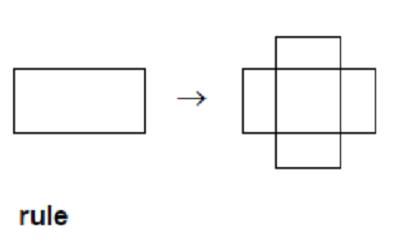
Shape Grammars
Introduction of Shape Grammars (SG)
Shape Grammar (SG) represents a language of design. A textual grammar is a set of rules that state how words in a language may be composed into sentences in that language. Likewise, SG is a set of shape replacement rules that can be applied consecutively to manipulate a set of primitive shapes (such as point, line, plane or solid) through geometrical transformations (such as addition, subtraction, translation, rotation and mirroring) to generate infinitely many instances of shape arrangements conforming to the specified rules in a non-deterministic manner (see Figure 2). There are certain similarities between SG and Rule-Based Reasoning (RBR) because both contain production rules. However, the nature of the rules varies. What differentiates SG from a traditional RBR are (a) geometry, (b) parameterisation, and (c) emergence. Traditional RBR lacks a sufficient geometric representation and general approach to reasoning about geometric forms. Moreover, RBR cannot produce innovative designs by just combining the information contained within its set of production rules. In contrast, SG can handle and reason based on geometry directly and has the ability to operate based on a parametric geometric representation. The key characteristic of SG formalism is that the shapes are treated as collections of geometrical entities rather than discrete objects. This makes it possible to support emergence - the ability to recognise non-predefined shapes in the designs and provide the mechanism for the creation of new design languages. Due to these characteristics, SG has originally been shown to be an effective tool for design analysis and synthesis in the architecture literature. SG is used for geometric manipulation and transformation while the knowledge-based model is used for supporting non-geometric contextual information. The knowledge base contains information that can support SG to perform selection of rules and generation of designs through exchange of information and query between two systems. This approach shows that the combinatory nature of the design rules captured by SG and 'Ontology' has a high potential for representing, maintaining and processing geometry-related engineering design knowledge.
Nature-Inspired Computing Applications for Design Automation and Optimisation

Research & Development Limited




Figure 2 Examples of primitive shapes generated by applying a SG rule
Challenges of combinatorial layout design using SG
However, the usefulness of SG for design synthesis largely depends on the recognition of "interesting" shapes. In other words, it heavily relies on the grammar writer's ability to establish a useful and comprehensive SG for a specific design domain. Moreover, it also depends on the designer's knowledge and expertise to manipulate the SG for generating a good design.
Copyright 2015. NiCADa Research & Development Company Limited. All Rights Reserved.